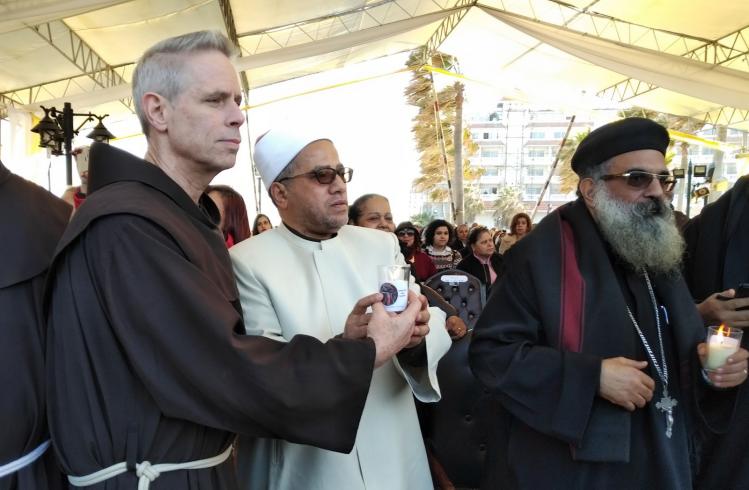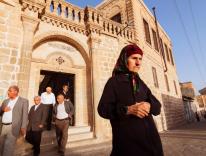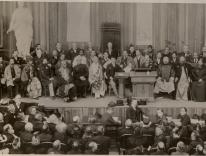
Once a little-known event in the life of one of the best-known saints, the encounter between Francis of Assisi and Egypt’s Sultan Malik al-Kamil during the Fifth Crusade is drawing widespread attention during its eight-hundredth anniversary year. Pope Francis set the tone in January by citing it as he told Vatican diplomats of plans to visit Morocco and the United Arab Emirates.
In February, the pope presented the crown prince of the UAE with a framed medallion of the saint and the sultan embracing. And he spoke of the encounter on March 30 during his visit to Morocco: “That prophetic event shows that the courage to encounter one another and extend a hand of friendship is a pathway of peace and harmony for humanity, whereas extremism and hatred cause division and destruction.”
The Franciscans in their various branches have embraced the anniversary. Conferences are being held in Damietta, Egypt; Jerusalem; Rome; Venice; Murcia, Spain; Istanbul; and Paris. Many events have included interreligious activity: in Manila, Lahore, Bangkok, and various locations in India, including Bengaluru. Other signs of interest include commemorative postage stamps issued in Germany and Italy, and a play presented at the Royal Welsh College of Music and Drama.
I took part in one of these events, a commemoration that the Order of Friars Minor Special Commission on Dialogue with Islam held in Istanbul from September 9-15. It came ten years after the release of a book I wrote on the encounter between saint and sultan, giving me a chance to consider how our knowledge of the meeting has developed in the last decade, and how it is being used as a model for easing Christian-Muslim tensions.
Certainly, the events that occurred in the sultan’s camp south of the besieged city of Damietta in 1219, probably in September, are much better known now. Much credit for that goes to Unity Productions Foundation, which released the PBS docudrama The Sultan and the Saint in 2016. (I was a consultant for the production.) In particular, the film has raised Muslims’ awareness of this encounter and its significance.
The Istanbul conference was attended by a mix of noted Franciscan scholars and pastoral workers, mostly Franciscan sisters and friars engaged in interreligious work with Muslims in countries such as Indonesia, Malaysia, Pakistan, India, Morocco, and the Philippines. One of the speakers, the Rev. Joseph Victor Edwin, a Jesuit from India, described how he aired the documentary before dozens of groups to improve relations among Muslims, Hindus, and Christians.
The story of the encounter does indeed contain many lessons. As he noted, the sultan listened to Francis; it is recorded that he permitted the friar to preach in his camp for several days during a lull in the fighting of the Fifth Crusade. The story depicts Francis crossing a battlefield to reach out to his enemy. And, given the courtesy of the encounter, it shows the possibility of building relationships to transcend differences. Father Edwin said he’s found time and again that the story of this encounter opens minds and hearts but, he acknowledged, it is difficult to overcome prejudice when it is based in ideology.
Although the eight-hundred-year-old encounter has been highlighted by the leadership of the Franciscan order and by three popes—St. John Paul II and Benedict XVI, along with Francis—its historical nature is very much in dispute. It’s clear that the meeting did in fact occur. Father Gwénolé Jeusset, a French scholar who has played a leading role in Franciscan outreach to Muslims for some five decades, noted in his Istanbul presentation that there are nine documented sources within the first fifteen years after the encounter.
The problem with the sources is that the Franciscan accounts tend to be shaped by the power struggles waged within the order during the first century after its founder’s death. What initially is presented in the Franciscan chronicles as a peaceful encounter becomes, by the 1260s, a very confrontational one in St. Bonaventure’s Major Legend of St. Francis. The most reliable sources are two documents from a non-Franciscan source, Jacques de Vitry, who was bishop of Acre and a future cardinal who participated enthusiastically in the (in my view) unjustified, brutal Fifth Crusade. He establishes the basic facts in a letter to friends in France in early 1220 and a subsequent Crusade history written between 1221 and 1226.
Without identifying Francis by name, the bishop wrote to his friends that “He was so inflamed with zeal for the faith that he did not fear to cross the lines to the army of our enemy. For several days he preached the Word of God to the Saracens and made a little progress. The Sultan, the ruler of Egypt, privately asked him to pray to the Lord for him, so that he might be inspired by God to adhere to that religion which most pleased God” (as translated in Francis of Assisi: Early Documents). The historical work takes a more formal tone in keeping with the bishop’s rather grand (and still important) world history. It adds some details and shifts the quote attributed to Sultan al-Kamil:
When that cruel beast saw Francis, he recognized him as a man of God and changed his attitude into one of gentleness, and for some days he listened very attentively to Francis as he preached the faith of Christ to him and his followers. But ultimately, fearing that some of his soldiers would be converted to the Lord by the efficacy of his words and pass over to the Christian army, he ordered that Francis be returned to our camp with all reverence and security. At the end he said to Francis: “Pray for me, that God may deign to reveal to me the law and the faith which is more pleasing to Him.”
We know from this that the encounter did occur, that it was peaceful and courteous, that Francis was permitted to preach for at least several days and that he evidently pleased the sultan. The sheer courtesy exhibited in the midst of an agonizing war (all 80,000 residents of Damietta, a city at the mouth of the Nile, would die as a result of the siege) has made it a starting point for interreligious dialogue, a concept that didn’t really exist eight-hundred years ago.
It’s more difficult to discern the motive for the encounter. Representing the sultan’s point of view, we have only Christian sources and, as Father Jeusset said in his presentation, the authors don’t understand Islam. Jacques de Vitry’s description of the sultan as a “cruel beast” was standard apocalyptic rhetoric at the time, but it makes the bishop out to be an ingrate. As he knew full well, the sultan had become a humanitarian hero to the Crusade leaders because he allowed them to surrender peacefully, and fed the troops until they could exit Egypt unscathed. (The Crusaders conquered Damietta but were trapped as they advanced further into Egypt after al-Kamil, expert on the phases of the Nile, raised the water levels to engulf them in mud.)
The Christians were so happy with the sultan that they began to assume that he was secretly a Christian—for how could a Muslim act with such compassion? As more and more Muslim scholars examine the encounter, we are getting a more detailed picture of how Islamic teachings informed the sultan’s exemplary mercy for his vanquished foes. Al-Kamil, a nephew of Saladin known for his friendship with Egypt’s Christians, is a fascinating historical figure.
A number of academic historians say that there is not enough historical evidence to determine what happened between Francis and the sultan, or why Francis ventured to cross the battlefield. John Tolan, an accomplished medieval scholar, makes that case in his book Saint Francis and the Sultan, which evaluates centuries of artistic and literary references to the encounter.
The thirteenth-century Franciscan accounts of Francis’s life emphasize the saint’s “thirst for martyrdom” as his motive for seeking out the sultan in 1219—the third time he had tried to travel to a Muslim land. But in one intriguing passage in a life of Francis written by Friar Thomas of Celano in the 1240s, Francis is reported as “forbidding war,” preaching to the troops against going to battle on “this day.”
Scholars have argued to a standstill about whether this shows that Francis was opposed the Fifth Crusade, or whether he was simply saying it was imprudent to fight on that particular day. Father Michael Cusato, a Franciscan scholar who spoke at the conference, said that the hagiographer could not very well write plainly that Francis opposed the Crusade. Rather, he said, it was “coded” language aimed at challenging a new and ultimately failed Crusade that King Louis IX was preparing for Damietta at the time.
Franciscan scholars have sought to rely on Francis’s own writings as the most reliable guide to what happened between him and the sultan. The late Jan Hoeberichts, a Dutch scholar and former Franciscan whose spirit seemed very much a part of the Istanbul event, pointed the way with his 1997 book Francis and Islam. He elaborated on these ideas in a 2012 book, available in English as Francis and the Sultan: Men of Peace (2018). Francis didn’t directly address his encounter with the sultan in the writings we have, but, as Hoeberichts and other Franciscans have written, the spirit of the encounter is reflected in a document Francis wrote after returning from Egypt: the Earlier Rule. In Chapter 16, Francis proposes that the friars can “live spiritually among the Saracens” and even “be subject” to all rather than engage in disputes. It was a revolutionary approach, given that the Fifth Crusade was still being fought. The idea that Francis was only interested in martyrdom was a “politically correct” solution to the embarrassment that the order’s founder had peaceful intentions toward Muslims, Hoeberichts wrote.
Franciscan scholars have combed through Francis’s writings to find many other echoes of the saint’s Damietta experience, and as Hoeberichts’s book shows, they continue to find allusions that strengthen the case for portraying the 1219 encounter as a model to consider today.
My own take, which I spoke about at the Istanbul commemoration, is that there is strong circumstantial evidence to support the argument that Francis came to oppose the Crusade and sought to make peace by converting the sultan. And circumstantial evidence does not mean weak evidence, as it is colloquially understood. Many a judge has instructed a jury that circumstantial evidence can be powerful enough to prove a case beyond any reasonable doubt.
We have to view Francis’s journey in Egypt in light of his devastating, formative experience as a cavalryman on the losing side in a battle that turned into a massacre. As a young man, he fought for Assisi against its more powerful neighbor, Perugia. The massacre and his ensuing year as a prisoner of war in a deep, dark, damp hole in the ground traumatized Francis and precipitated his “conversion,” which, as he wrote late in his life, was ultimately achieved when he worked up the nerve to kiss a leper.
As a traumatized veteran, Francis adopted a life of voluntary poverty to escape the cycle of violence. From the first, he preached peace and penance; he sought to end warfare wherever he encountered it. He did not stop doing that in Egypt.
Some historians hold out for the document that will say, very directly, that Francis opposed the Crusade. But the early Franciscan accounts of Francis’s life could never say that. How could someone be a great saint and oppose the popes’ wars? We can be sure that if Francis ever uttered a word in support of the Crusade, or bad-mouthed Islam, it would have appeared in the early accounts. As Sherlock Holmes might put it, this is “the dog that didn’t bark”: the silence is circumstantial evidence. Francis disarmed his rhetoric. He taught by example; he reached out to the sultan at a time when the papal legate in the Crusader camp was blocking peace negotiations.
For a good account of recent scholarship on the Francis-sultan encounter, see the March 2019 issue of the journal The Muslim World, published at Hartford Seminary. (It is available online.) The editors, Fareed Z. Munir, a professor at Siena College, and Fr. Jason Welle, a Franciscan scholar and dean at the Pontifical Institute for Arabic and Islamic Studies in Rome (and a participant in the Istanbul commemoration) provide a helpful overview. The friars’ Special Commission on Dialogue with Islam, headed by Fr. Michael Calabria, professor and director of the Center for Arab and Islamic Studies at St. Bonaventure University, has published a commemorative booklet as well.
These continued studies provide the basis to go forward with reconciliation and dialogue—to take an event that was ignored or misconstrued for centuries and use it as a tool to build relationships in place of fear and distrust. As I learned from Franciscans living in such predominantly Muslim countries as Morocco and Pakistan, there simply has to be Christian-Muslim dialogue. The takeaway from Istanbul: there is no good alternative.
Please email comments to [email protected] and join the conversation on our Facebook page.
Previous Story
Religion Booknotes
Next Story
All Together Now

